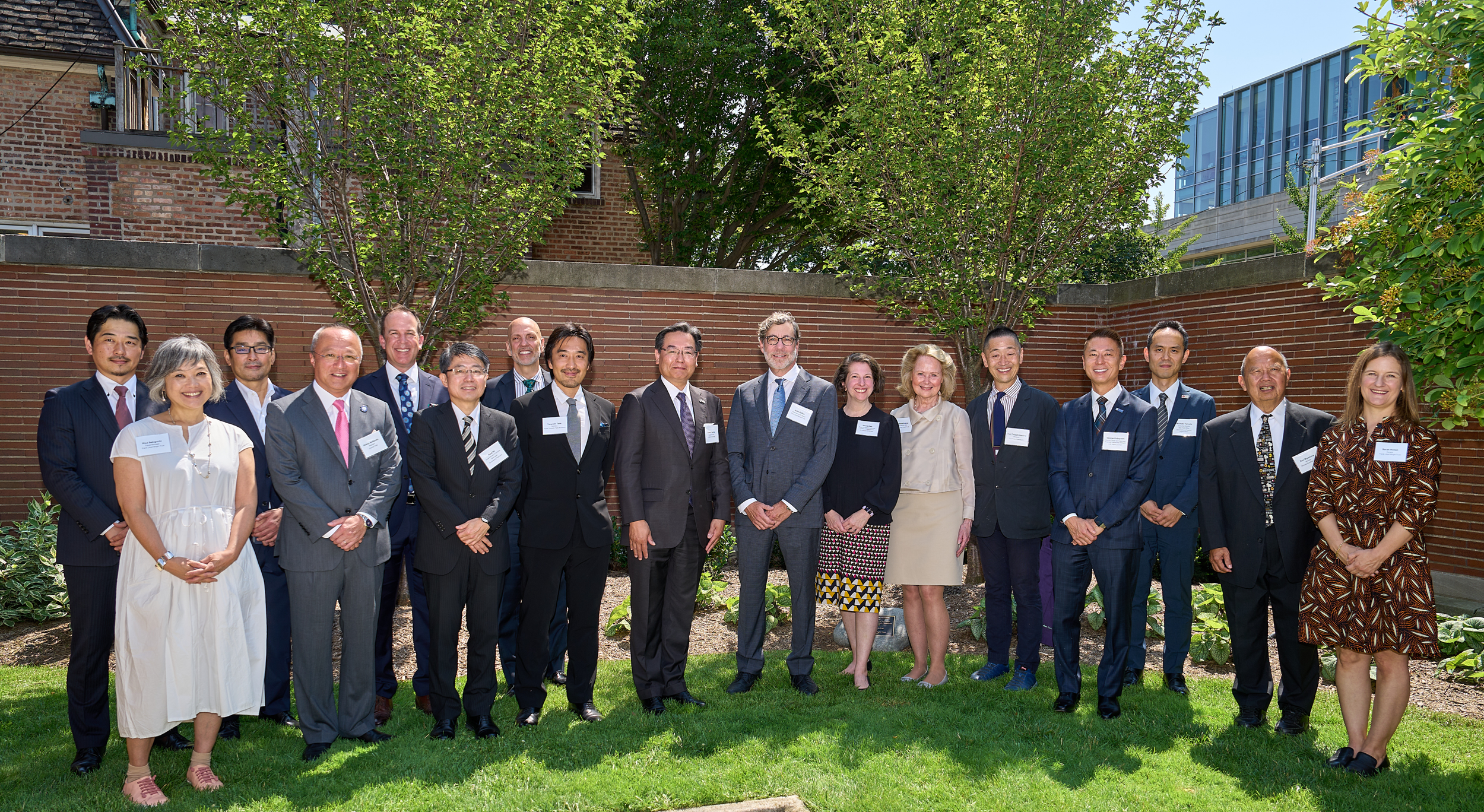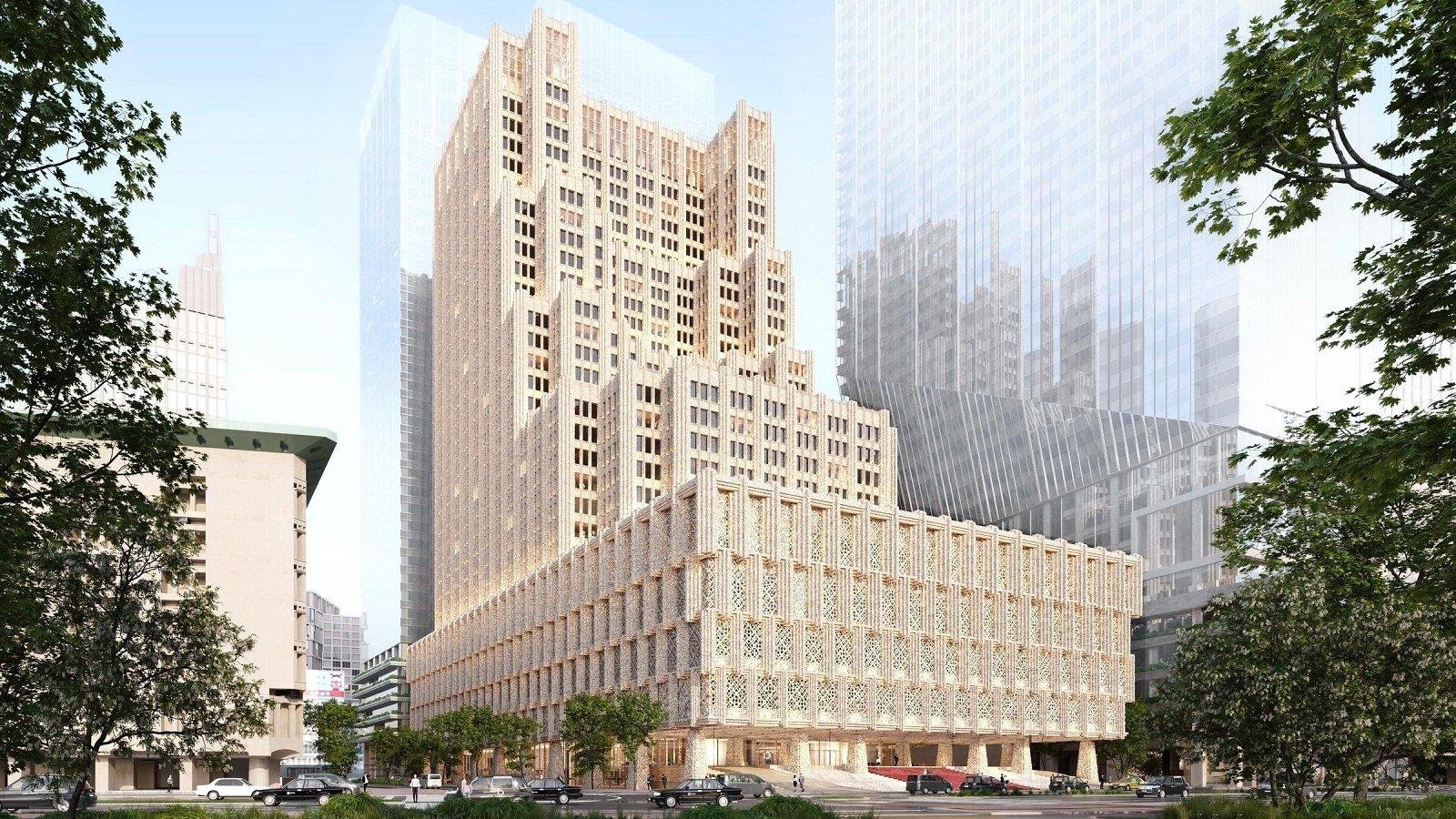Celebrating the Centennial of Wright’s Imperial Hotel (1923-2023) with Cherry Trees at Wright’s Robie House in Hyde Park, Chicago
Imperial Hotel and Frank Lloyd Wright Trust representatives in the Courtyard, Frederick C. Robie House (Frank Lloyd Wright, 1908-10), Chicago. Courtesy of Frank Lloyd Wright Trust, Chicago
On July 18, 2023, The Imperial Hotel, Ltd. and the Frank Lloyd Wright Trust celebrated the 100th anniversary of Wright’s 1923 Imperial Hotel, Tokyo, with a private dedication of cherry trees planted in the courtyard of Frank Lloyd Wright’s Frederick C. Robie House, Chicago, a UNESCO World Heritage site.
An inscription plaque reads: These cherry trees celebrate 100 years of our shared cultural heritage. The Wright Imperial Hotel Centennial 1923-2023. Imperial Hotel, Ltd., Tokyo, Frank Lloyd Wright Trust, Chicago.
Inscription Plaque, Courtyard, Frederick C. Robie House (Frank Lloyd Wright, 1908-10), Chicago. Courtesy of Frank Lloyd Wright Trust, Chicago
United States Ambassador to Japan and former Mayor of Chicago, Rahm Emanuel, sent a message to mark the occasion.
“One of Chicago’s chief cultural contributions worldwide is architecture. I was proud to support the Frank Lloyd Wright Trust and Robie House as Chicago’s first UNESCO World Heritage site. Wright's legacy is captured in the brilliance of what he built, but also in the ability to inspire ingenuity that transcended countries, namely the United States and Japan. Given Frank Lloyd Wright’s great gift to bridge two cultures, two nations, and two peoples, it's fitting that the Imperial Hotel and Frank Lloyd Wright Trust celebrate the centennial of Wright’s Imperial at Robie House.”
Ms. Celeste Adams, Trust President stated,
“Wright’s lifelong fascination with Japanese art and culture began in Chicago where he first encountered Japanese architecture at the 1893 World’s Columbian Exposition in Jackson Park, a mile from the site of Robie House.”
The Phoenix Pavilion, 1893 World’s Columbian Exposition at Chicago. Courtesy of UMIIMU, Inc.
The Phoenix Pavilion, which Wright encountered at the World’s Columbian Exposition, was located at the north end of the Wooded Island in the area that is today known as the Garden of the Phoenix. SKYLANDING by Yoko Ono stands on the site of the Phoenix Pavilion, which was lost to arson in 1946.
In 1905 Wright traveled outside the U.S. for the first time, spending three months in Japan. In 1908 Wright received the commission for Robie House, completed in 1910.
Exterior from 58th Street, Frederick C. Robie House (Frank Lloyd Wright, 1908-10), Chicago. Courtesy of Frank Lloyd Wright Trust, Chicago
While several of his prior buildings are influenced by Japanese architecture, Robie House has the most striking affinity, often observed by Japanese visitors. During 1913 a conversation began between Frank Lloyd Wright and Aisaku Hayashi, Manager of the Imperial Hotel. On March 17, 1916, Wright formally accepted the commission for a modern hotel to replace the original Imperial Hotel, which had opened in 1890.
Wright lived in Japan intermittently during the design and construction of the Imperial Hotel, which opened on September 1, 1923, the day of the Great Kanto Earthquake. The Imperial survived, and Wright considered it his masterpiece. After the Imperial Hotel project, Wright never again returned to Japan, but the 30-year span from his 1893 encounter with Japanese architecture in Chicago to the 1923 opening of the Imperial Hotel engendered lasting friendships and professional relationships spanning generations.
Frank Lloyd Wright (far left), Aisaku Hayashi (right of Wright) in front of the Imperial Hotel, 1922. Courtesy of UMIIMU, Inc.
“This building – the new Imperial Hotel of Tokyo – is not designed to be a Japanese building: it is an artist’s tribute to Japan, modern and universal in character.”
“The new Imperial Hotel is an offering to Japan in this her time of trial by an artist who owes much to her ancient spirit, one who would contribute his might to repay the debt, hoping to awaken and inspire his Japanese brothers in architecture to independent efforts of their own.”
- FRANK LLYOD WRIGHT, 1922
Wright’s Imperial became a center for social and cross-cultural exchange. In this spirit, the Imperial Hotel, Ltd. and the Frank Lloyd Wright Trust celebrate the power of architecture and the value of cultural heritage as a foundation for enduring international friendship.
Mr. Hideya Sadayasu, President of The Imperial Hotel, Ltd. stated,
"This year, the Imperial Hotel honors the architecture of Frank Lloyd Wright. We are pleased to celebrate the 100th anniversary of Wright’s Imperial at the iconic Robie House in Chicago, the city where Wright established his reputation and home to a majority of his extant works. We hope that the cherry trees we plant with the Trust will grow for many years to come, in honor of Wright’s achievements in Japan and the United States.”
Imperial Hotel President Hideya Sadayasu, Architect Tsuyoshi Tane, Consul General of Japan Hiroshi Tajima, and Japan Information Center Director Tsutomu Shibata. Courtesy of Frank Lloyd Wright Trust, Chicago
In 2021, the Imperial Hotel in Tokyo announced plans for a fourth-generation new main building for completion in 2036. Appointed to design the new building is Paris-based architect Tsuyoshi Tane.
Perspective image of the new main building of the Imperial Hotel Tokyo to be designed by Tsuyoshi Tane. Image: ©️Atelier Tsuyoshi Tane Architects
The Imperial Hotel opened in 1890 in Uchisaiwaicho, Chiyoda City, Tokyo, as a guest house for entertaining foreign guests. Its first main building was designed by Yuzuru Watanabe in the Western style, while its second main building was designed by Frank Lloyd Wright in 1923. It was rebuilt once more in 1970 with a design by Teitaro Takahashi, followed by the construction of the Imperial Hotel Tower skyscraper on the Ginza side in 1983.
Entrusted with the important task of designing the fourth-generation building is architect Tsuyoshi Tane, born in Tokyo in 1979. He became widely known at the age of 26 after winning an international competition with Dan Dorell and Lina Ghotmeh to design the Estonian National Museum. In 2017, ATTA—his Atelier Tsuyoshi Tane Architects, which undertakes projects all around the globe, opened in Paris.
Like Aisaku Hayashi, the Imperial Hotel General Manager who picked Frank Lloyd Wright, Imperial Hotel President Hideya Sadayasu considers the selection of Tyuyoshi Tane equally as important.
Mr. Sadayasu explained at the Robie House, with Mr. Tane present, that “Mr. Tane is a partner who understands the hotel’s past and can create a unique and new guesthouse for the nation. Mr. Tane can fuse the palace concept that welcomes guests with a tower that is a proof of human progress.”
Tsuyoshi Tane in his office in Paris, France. Photo: Yuji Ono
But what will the new Imperial Hotel Tokyo main building, scheduled for completion in 2036, be like? Tane gives us his insight. The following is an interview conducted in 2022 by Yui Ide(CCC Media House - Translation by Amitt)
How did you interpret the three elements of dignity, inheritance, and challenge that the Imperial Hotel sought after for the new main building?
I thought that the new main building would inherit the hotel's dignity and history while representing a new challenge. The first main building was a guest house built for Western guests after Japan's opening to the West. The second, the Wright building, established the hotel's international identity as a jewel of the Orient. This is a reputation befitting only such a grand hotel, and one that has grown with the times and continues to grow to the present day. In full awareness of the significance of each of these buildings, I searched for my own way forward. I have consistently held the view that it is best to continue what has existed in the past and connect it to the future, in order to create a long-term vision.
When you design, you often conduct research to unearth the memories of a place, like an archaeologist. What kind of research did you carry out this time?
I focused not only on its prestigious nature as a grand hotel, but also on the fact that it would be a place where distinguished guests from abroad would visit and where ceremonies and events would be held. I designed the lower-level foundation in consideration of the ideal form and composition of space. I studied theaters, including the opera houses, temples, and palaces of ancient Mesopotamia, Egypt, and the Orient, as well as European court culture.
The higher-level section that stands behind the foundation symbolizes the progress of humanity, in endless pursuit of tall towers. Firstly, I returned to the architecture of the Chicago School of the 19th century, including Wright's mentor, Louis Sullivan. They designed the first steel-framed skyscrapers, constructed using stone and brick, and they're really amazing. The New York School of steel and glass skyscrapers that followed swept the world. However, to create a vision of the future for the Imperial Hotel, I decided to look back to the Chicago School, basing the design on this primordial principle of building towers.
Why did you choose the concept of the "Jewel of the Orient," a phrase used to describe the Wright building?
This notion of the Orient, or Oriental wisdom, offers a different kind of richness from that of technological progress. It's the wisdom of memory, in which knowledge and experience are accumulated by human beings. It's my hope that the hospitality offered by the Imperial Hotel will continue to express human wisdom and culture into the future. I hope to make this a building that represents the glorious wisdom connecting East with West.
These days, sustainability is a priority. As an architect, what are you conscious of?
I want to create architecture that has a long lifespan. Architecture and culture used to have enduring permanence, but now the human lifespan is longer, so buildings are being torn down one after another and urban spaces are changing. I have misgivings about the short lifespan of these buildings. If we go on like this, we will have no wealth of culture to leave to the next generation. I think this is a significant issue.








